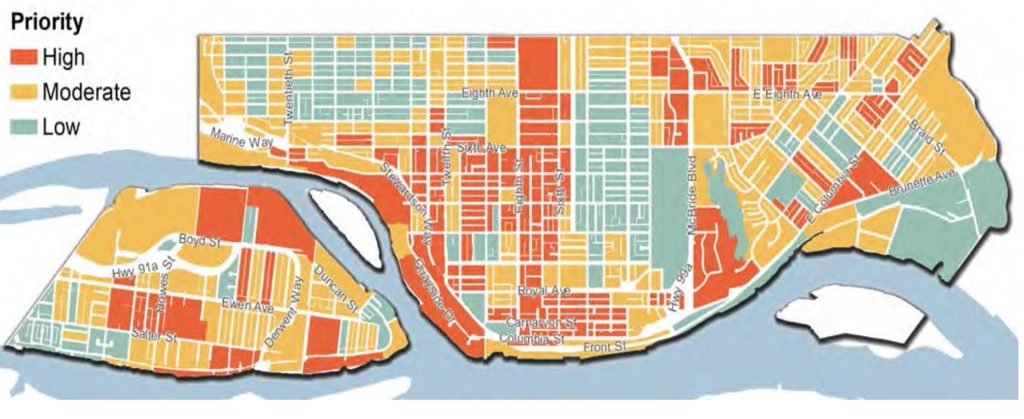AM asked—
Curious to know where the city is at with it’s tree planting roll out for street trees. Sapperton residents would appreciate and benefit from some shade. I live on Simpson and have been asking for street trees for 5 years. Many thanks
Short answer: As far as I can tell, New Westminster is on pace, or slightly ahead of pace, on the tree planning strategy approved in 2020, and the good news is that Simpson Street is a high-priority street for planting, so you should hopefully see new street trees in the next year or so.
The City is planting a lot of trees. This followed on a few years of working on an Urban Forest Management Strategy that is one of the things I am most proud of during my time on Council. After decades of a slowly eroding tree canopy, the City committed in 2016 to turning that tide, and going from 18% forest cover (measured in 2014) to 27% cover by 2035.
A 9% increase in tree cover might not sound like a lot, but it would require an additional 8,500 trees planted on public lands and 3,300 trees planted on private lands. That means more than 800 new trees a year, not including the trees we needed to replace any lost through development and natural tree death. There are four strategies to get there: A proactive Tree Bylaw to protect as best we can healthy mature trees on private property; incentivizing private tree plantings through tree sales and promotion; investing in urban reforestation where opportunities arise such as parklands; and committing to an aggressive Street Tree planting program. The last two of these are supported by our 2020-2030 Tree Planting Master Plan.
That plan is a great read, and I like how staff prioritized different parts of the City for faster planting. Recognizing that tree cover is inequitably distributed round the City, and that it would be better if we more evenly distributed that social, health, and economic benefits of tree canopy cover, staff used a GIS system to map out a few measures. Along with measuring areas with less trees, they also prioritize multi-family neighbourhoods to put more people near trees, neighbourhoods with more seniors, and areas more susceptible to Urban Heat Island effect. Overlaying those layers, and higher vs. low priority areas stand out:

It is also worth noting, this isn’t just about going out with a back hoe, digging a hole, and plopping a sapling in the hole. Trees need some significant support to prosper in urban areas, especially in the first few years. With asphalt and concrete everywhere, there is not enough healthy water-and-nutrient-providing soil around a tree in many areas, so a soil cell needs to be constructed to give the roots a chance to establish. Trees are sensitive to drought and frost and wind until they get established, so they need watering, they need pruning, and other care in the first few years. If we lose 10% of the new plantings every year, we are doing pretty well. They also need to be planted mindfully so they don’t tear up the sidewalk next to them, or mess up the sewer lines under them. And with climate change, we need to be cognizant of the species planted and the diseases and pets that are endemic. For our tree strategy to be successful, we needed staff dedicated to this work.
Fortunately, we are getting grants both large and small to help us with this work, and are committed though our Climate Action Strategy to continue to fund this work. It also helps that we have both staff and a Council who recognize that planting a tree today is an investment worth making so we have a better community 20 years down the road.
As for that block of Simpson Street between Columbia and Richmond: there is an identified paucity of street trees there, which means you will be getting those street trees sooner than some of the rest of Sapperton. It’s that red block in the picture above. Of course the overhead power lines are on the north side of the road. That means more diminutive trees on the north side but the south side should be able to host full-sized trees, and provide a lot of shade across the street. I’m assuming (but don’t know for sure) that there are no utility conflicts under the boulevard that would limit root fecundity. And it looks like the City is planning hop hornbeams and Chitalpas. So spring flowers to boot!